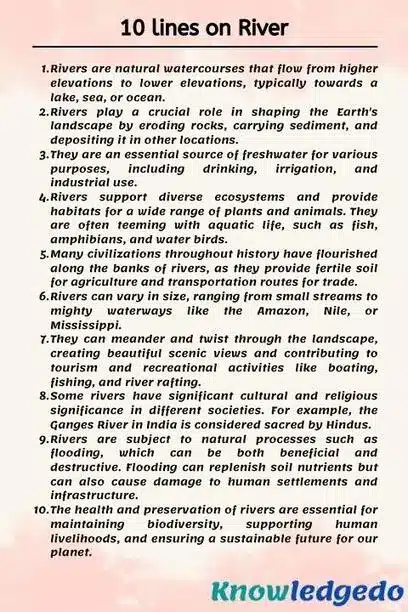Today, we are sharing 10 lines on River in English. This article can help students who are looking for information about 10 lines on River. This Lines is very simple and easy to remember. The level of these Lines is moderate so any student can write on this topic.
This article is generally useful for class 1,class 2,class 3,class 4,class 5,class 6,class 7,class 8,class 9,class 10,class 11,class 12
10 lines on River
1) Rivers are natural watercourses that flow from higher elevations to lower elevations, typically towards a lake, sea, or ocean.
2) Rivers play a crucial role in shaping the Earth’s landscape by eroding rocks, carrying sediment, and depositing it in other locations.
3) They are an essential source of fresh water for various purposes, including drinking, irrigation, and industrial use.
4) Rivers support diverse ecosystems and provide habitats for a wide range of plants and animals. They are often teeming with aquatic life, such as fish, amphibians, and water birds.
5) Many civilizations throughout history have flourished along the banks of rivers, as they provide fertile soil for agriculture and transportation routes for trade.
6) Rivers can vary in size, ranging from small streams to mighty waterways like the Amazon, Nile, or Mississippi.
7) They can meander and twist through the landscape, creating beautiful scenic views and contributing to tourism and recreational activities like boating, fishing, and river rafting.
8) Some rivers have significant cultural and religious significance in different societies. For example, the Ganges River in India is considered sacred by Hindus.
9) Rivers are subject to natural processes such as flooding, which can be both beneficial and destructive. Flooding can replenish soil nutrients but can also cause damage to human settlements and infrastructure.
10) The health and preservation of rivers are essential for maintaining biodiversity, supporting human livelihoods, and ensuring a sustainable future for our planet.

5 lines on River
1) Rivers are natural watercourses that flow from higher elevations to lower elevations, shaping the Earth’s landscape.
2) They provide a vital source of freshwater for drinking, irrigation, and various industrial uses.
3) Rivers support diverse ecosystems, providing habitats for numerous plants and animals.
4) They have played a significant role in the development of civilizations throughout history, offering fertile soil for agriculture and transportation routes for trade.
5) Rivers offer opportunities for recreational activities like boating, fishing, and riverfront tourism.
FAQ
Rivers are formed through a combination of processes such as precipitation, runoff, and the movement of groundwater. Rainfall and melting snow contribute to the accumulation of water in higher elevations, which then flows downhill, gradually forming streams and rivers.
Several factors influence the flow and characteristics of a river, including the amount and distribution of precipitation in its watershed, the shape of the land it flows through, the vegetation cover along its banks, and the geology of the area. Human activities, such as dam construction and water extraction, can also significantly impact a river’s flow and characteristics.
Rivers play a crucial role in supporting human society in various ways. They provide a source of fresh water for drinking, irrigation, and industrial use. Rivers also serve as transportation corridors, facilitating trade and commerce. Moreover, rivers support diverse ecosystems, provide habitats for wildlife, and offer recreational opportunities for fishing, boating, and other activities. Additionally, many cultures and civilizations have relied on rivers for their livelihoods, agriculture, and spiritual significance.
